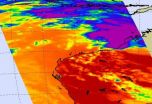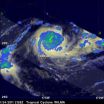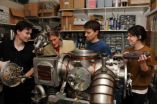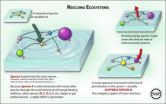Armchair nanoribbons made into spintronic device
Discovery by Iranian physicists promises cheaper electronics down the road
2011-01-26
(Press-News.org) Washington, D.C. (January 25, 2011) -- In a development that may revolutionize handheld electronics, flat-panel displays, touch panels, electronic ink, and solar cells, as well as drastically reduce their manufacturing costs, physicists in Iran have created a spintronic device based on "armchair" graphene nanoribbons. Spintronic devices are being pursued by the semiconductor and electronics industries because they promise to be smaller, more versatile, and much faster than today's electronics.
As described in the American Institute of Physics journal Applied Physics Letters, nanoribbons such as these could one day replace indium tin oxide -- an expensive material for which researchers have been searching for suitable substitutes.
Nanoribbons are carbon nanotubes that have been "unzipped" using a room-temperature chemical process to produce ultrathin, flat ribbons of straight-edged sheets of graphene. Finite, narrow strips of graphene are cut out from a two-dimensional sheet of graphene to create the nanoribbons. And depending on how the ribbon is cut out, it results in either an "armchair" or a zigzag edge. An armchair ribbon can be thought of as essentially an unrolled zigzag nanotube.
"We proposed an electronic spin-filter device using nonmagnetic materials. Our system, which is an all-carbon device, passes only one type of spin current," says Alireza Saffarzadeh, an associate professor in the Department of Physics at Payame Noor University. This property is due to the finite-size effect and geometry of the zigzag-edge graphene nanoribbons, Saffarzadeh explains.
"By applying a gate voltage, the type of spin current can be switched from spin-up to spin-down or vice versa," Saffarzadeh says. "For this reason, the system acts as a spin switch. And these properties are useful in spintronic applications, such as magnetic random access memory."
Saffarzadeh and colleague Roohala Farghadan, a Ph.D. student in Tarbiat Modares University's Department of Physics, found that graphene nanoribbons are good candidates for electronic and spintronic devices due to high carrier mobility, long spin-relaxation times and lengths, and spin-filtering abilities.
###
The article, "A spin-filter device based on armchair graphene nanoribbons," by A. Saffarazadeh and R. Farghadan appears in the journal Applied Physics Letters. See: http://link.aip.org/link/applab/v98/i2/p023106/s1
Journalists may request a free PDF of this article by contacting jbardi@aip.org
ABOUT APPLIED PHYSICS LETTERS
Applied Physics Letters, published by the American Institute of Physics, features concise, up-to-date reports on significant new findings in applied physics. Emphasizing rapid dissemination of key data and new physical insights, Applied Physics Letters offers prompt publication of new experimental and theoretical papers bearing on applications of physics phenomena to all branches of science, engineering, and modern technology. Content is published online daily, collected into weekly online and printed issues (52 issues per year). See: http://apl.aip.org/
ABOUT AIP
The American Institute of Physics is a federation of 10 physical science societies representing more than 135,000 scientists, engineers, and educators and is one of the world's largest publishers of scientific information in the physical sciences. Offering partnership solutions for scientific societies and for similar organizations in science and engineering, AIP is a leader in the field of electronic publishing of scholarly journals. AIP publishes 12 journals (some of which are the most highly cited in their respective fields), two magazines, including its flagship publication Physics Today; and the AIP Conference Proceedings series. Its online publishing platform Scitation hosts nearly two million articles from more than 185 scholarly journals and other publications of 28 learned society publishers.
END
ELSE PRESS RELEASES FROM THIS DATE:
2011-01-26
CHESTNUT HILL, MA (1/25/11) -- Researchers from Boston College, MIT, Clemson and Virginia have used nanotechnology to achieve a 60-90 percent increase in the thermoelectric figure of merit of p-type half-Heusler, a common bulk semiconductor compound, the team reported in the American Chemical Society journal Nano Letters.
The dramatic increase in the figure of merit, used to measure a material's relative thermoelectric performance, could pave the way for a new generation of products – from car exhaust systems and power plants to solar power technology – that that runs ...
2011-01-26
Washington, D.C. (January 25, 2011) -- A team of physicists has taken a big step toward the development of useful graphene spintronic devices. The physicists, from the City University of Hong Kong and the University of Science and Technology of China, present their findings in the American Institute of Physics' Applied Physics Letters.
Graphene, a two-dimensional crystalline form of carbon, is being touted as a sort of "Holy Grail" of materials. It boasts properties such as a breaking strength 200 times greater than steel and, of great interest to the semiconductor and ...
2011-01-26
NASA's Aqua satellite captured an infrared image of the very cold clouds that house powerful thunderstorms within the Southern Indian Ocean's newest tropical depression, number 10S. The depression quickly strengthened into a tropical storm and continues to affect the northern coast of Western Australia.
When Aqua passed over the Tropical Storm 10S on January 25 at 05:53 UTC (12:53 a.m. EST), the Atmospheric Infrared Sounder (AIRS) instrument captured an infrared image of the storm's clouds. The image showed that most of the coldest cloud tops (-63 Fahrenheit/-52 Celsius) ...
2011-01-26
Boulder, CO, USA – The February issue of Geology is online now. Articles cover Patagonian glaciations, the Younger Dryas cold period, paleodiversity, submarine gullies, the Transantarctic Mountain micrometeorite collection, the "fastest glacier on Earth," salt diapirs in the Nordkapp Basin, reinterpretation of James Hutton's historic discovery on the Isle of Arran, a new tool to directly date dinosaur-bone fossils, ancient megalakes in Australia, Egypt's Kamil Crater, and more. GSA TODAY examines seismic activity to gain insights into the Rio Grande Rift.
Keywords: Ammonoids, ...
2011-01-26
Wilma caught the eye of NASA. NASA's Aqua satellite captured visible and infrared images of Cyclone Wilma in the Southwestern Pacific Ocean and her eye was clearly visible from space.
On January 25 at 00:59 UTC (8:59 p.m. EST on Jan. 24), the Atmospheric Infrared Sounder (AIRS) instrument captured data that was used to create infrared and visible images at NASA's Jet Propulsion Laboratory in Pasadena, Calif. The images showed Cyclone Wilma had strengthened overnight and now has a visible eye.
AIRS Infrared imagery showed strong, very cold thunderstorm cloud tops around ...
2011-01-26
SEATTLE – Women who have experienced hot flushes and other symptoms of menopause may have a 50 percent lower risk of developing the most common forms of breast cancer than postmenopausal women who have never had such symptoms, according to a recent study by researchers at Fred Hutchinson Cancer Research Center.
The results of the first study to examine the relationship between menopausal symptoms and breast cancer risk are available online ahead of the February print issue of Cancer Epidemiology Biomarkers and Prevention.
The protective effect appeared to increase along ...
2011-01-26
Charles Darwin based his groundbreaking theory of natural selection on the realization that genetic variation among organisms is the key to evolution.
Some individuals are better adapted to a given environment than others, making them more likely to survive and pass on their genes to future generations. But exactly how nature creates variation in the first place still poses somewhat of a puzzle to evolutionary biologists.
Now, Joanna Masel, associate professor in the UA's department of ecology and evolutionary biology, and postdoctoral fellow Etienne Rajon discovered ...
2011-01-26
Measuring the attractive forces between atoms and surfaces with unprecedented precision, University of Arizona physicists have produced data that could refine our understanding of the structure of atoms and improve nanotechnology. The discovery has been published in the journal Physical Review Letters.
Van der Waals forces are fundamental for chemistry, biology and physics. However, they are among the weakest known chemical interactions, so they are notoriously hard to study. This force is so weak that it is hard to notice in everyday life. But delve into the world of ...
2011-01-26
In an effort to better understand the dynamics of complex networks, scientists have developed a mathematical model to describe interactions within ecological food webs. This research, performed by Northwestern University physics professor Adilson Motter and his student, Sagar Sahasrabudhe, is published in the January 25 issue of Nature Communications. The work illustrates how human intervention may effectively aid species conservation efforts.
"Our study provides a theoretical basis for management efforts that would aim to mitigate extinction cascades in food web networks. ...
2011-01-26
Aneesoft Corporation, a leading digital multimedia software company, announces the release of Aneesoft Free Image Editor today, a free image editing software which fulfills all the basic needs of the average users.
Like a review from Softpedia.com, the second largest download site in Europe, said of Aneesoft Free Image Editor, "Image editing was never simpler". Aneesoft Free Image Editor supports most common image file format, such as .JPG, .PNG, .BMP, .GIF, etc. It provides some basic functions for image editing: crop, rotate, watermark and most attractive of all, various ...
LAST 30 PRESS RELEASES:
[Press-News.org] Armchair nanoribbons made into spintronic device
Discovery by Iranian physicists promises cheaper electronics down the road




